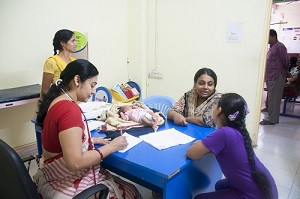Can impact investors make money and make a credible, discernible difference in the lives of the poor? The recent SSIR article "When Can Impact Investing Create Real Impact?" calls attention to this fundamental tension in the impact investing space and the challenges of estimating social returns. Impact investors struggle to identify measures that enable benchmarking and comparison about social impact across a portfolio, while entrepreneurs face large reporting burdens and the challenges of translating data in a meaningful, credible way.
There’s no doubt that impact measurement is important to impact investors. A 2012 survey of impact investors indicated that 98 percent of respondents think that impact measurement is important to the development of the industry. The Global Impact Investing Network (GIIN)’s updated definition of impact investment cites impact measurement as a core component of impact investing to ensure transparency and accountability, and to inform the practice of impact investing and build the field. Despite the recognition of impact measurement’s importance, many are still daunted by the task of establishing sound systems to meet their specific and sometimes unique needs.
This desire and struggle for impact measurement is happening just as some impact sectors are embracing the innovation and potential for financial sustainability that go hand-in-hand with market-based solutions.
Healthcare is one of these sectors. Donors, governments, and others are increasingly seeking ways to effectively harness the private sector to expand healthcare access in low- and middle-income countries. In parallel, social entrepreneurs have been launching social enterprises that provide needed health services in emerging markets.
Are you enjoying this article? Read more like this, plus SSIR's full archive of content, when you subscribe.
Health delivery organizations are eager to embrace an impact measurement framework/system that is comprehensive and credible, but also feasible and broadly comparable. It was with this understanding that our teams at the Center for Health Market Innovations (CHMI) and the Global Impact Investing Network (GIIN) jointly developed standardized definitions for common measures of performance tracked by healthcare organizations serving low-income communities. The metrics, which are now formally included in the GIIN’s IRIS catalog, are a practical tool to support investors in measuring the social, environmental, and financial performance of their investments to demonstrate how well they deliver affordably priced, quality services to the poor.
 A doctor providing maternal and child health services through Lifespring Hospitals, one of more than 240 organizations reporting performance results to the Center for Health Market Innovations. (Photo taken and provided by Lifespring Hospitals)
A doctor providing maternal and child health services through Lifespring Hospitals, one of more than 240 organizations reporting performance results to the Center for Health Market Innovations. (Photo taken and provided by Lifespring Hospitals)
Areas of focus span three core performance dimensions, including who is served, what is delivered, and how it is delivered. The emphasis on these metrics is that they seamlessly integrate into broader management systems. For example, by tracking the demographic and income level of clients, healthcare organizations can use this information to provide different types of financing to different groups of clients. Or by tracking quality assurance mechanisms, investors can better understand the range of quality processes in place, and also couple this with quality outcome data.
To create the new catalog of metrics, we convened a working group composed of healthcare practitioners, impact investors, and others with health implementation and metrics design expertise, including the University of Toronto's T-HOPE group. We designed the metrics with the following guidelines for healthcare organizations and funders interested in adopting standardized reporting metrics:
- Choose from within the catalog of metrics. There is no single combination of metrics that is right for every organization; this set is designed as a catalog that investors and healthcare organizations can use to select the most appropriate metrics for their work.
- Adapt metrics to specific healthcare activities. While the metrics are meant to be generally applicable to organizations delivering healthcare services, they should be tailored to reflect an organization’s area of focus. For example, an organization may wish to provide details on the total patients served by their organization and the number of patients served by a specific activity, for instance, attended newborn deliveries.
- Use the metrics to measure outputs and, ultimately, outcomes. Most metrics in the catalog are measures of activities or outputs of a healthcare delivery organization. We did this intentionally to provide the building blocks to measure health outcomes or impacts, which will vary by organization and investor.
- Use metrics to help identify successful health organizations. Comparable indicators of organizational performance can help organizations demonstrate impact and compare performance to similar organizations. Standardized metrics can also help investors channel funding into solutions that effectively address healthcare challenges.
Clearly, healthcare investors and their investees can benefit greatly from reliable and pragmatic performance metrics. For investors, this utility includes benchmarking and comparability across investments, and valuable information for screening and investment decisions. For healthcare organizations, common metrics can help reduce the reporting burden, support performance benchmarking, and demonstrate the impact of services. But most importantly, impact measurement (and management!) is essential to improving the performance of healthcare organizations and generating greater impact across the healthcare field.
The IRIS/CHMI catalog of metrics is now public and freely available here. Investors and health organizations can select and use the metrics that are relevant and most useful for their organizations’ goals—this will include the 1200-plus programs that are part of the CHMI network. The health catalog is one subset of a broader set of performance metrics released by IRIS that should greatly advance the ability to measure social returns. Investors and organizations can use the metrics today to demonstrate that positive financial returns and social returns can be successfully paired, and that they are delivering meaningful good to the world’s poor.
Support SSIR’s coverage of cross-sector solutions to global challenges.
Help us further the reach of innovative ideas. Donate today.
Read more stories by Christina Synowiec & Ellen Carey.

